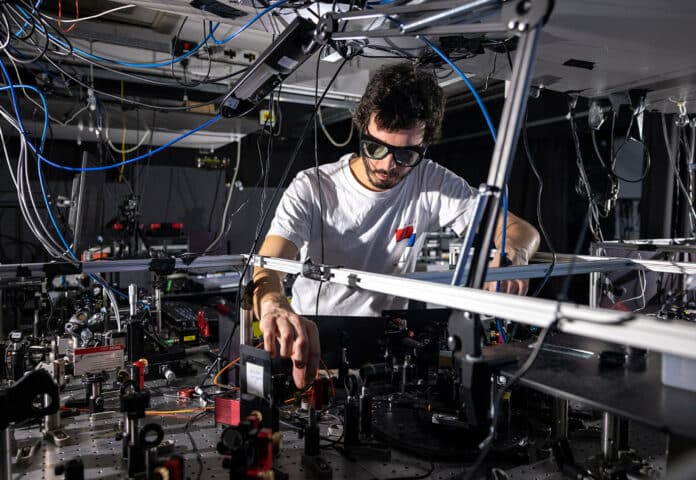The original double-slit configuration required shining light through two thin parallel slits in an opaque screen. A detector for light that traveled through the screen was located behind it.
Light separates into two waves that pass through each of the slits to move them as a wave. These waves “interfere” with one another when they cross over again on the opposite side. Peaks of the wave strengthen each other where they meet, whereas peaks and troughs cancel each other out. As a result, the detector develops a striped pattern with areas of greater and lesser light.
In the classic version of the experiment, light emerging from the physical slits changes its direction, so the interference pattern is written in the angular profile of the light.
Instead, the time slits in the new experiment change the frequency of the light, which alters its color. This created colors of light that interfere with each other, enhancing and canceling out specific colors to produce an interference-type pattern.
Now, a team led by Imperial College London physicists has performed the experiment using ‘slits’ in time rather than space. They have recreated the famous double-slit experiment, which showed light behaving as particles and a wave in time rather than space. They achieved this by firing light through a material that changes its properties in femtoseconds (quadrillionths of a second), only allowing light to pass through at specific times in quick succession.
Lead researcher Professor Riccardo Sapienza, from the Department of Physics at Imperial, said: “Our experiment reveals more about the fundamental nature of light while serving as a stepping-stone to creating the ultimate materials that can minutely control light in both space and time.”
The indium-tin-oxide thin film utilized in most mobile phone displays was the substance the team chose to work with. Lasers modified the material’s reflectance on rapid timescales, resulting in the “slits” for the light. The material changed its reflectivity in a matter of femtoseconds, significantly faster than the team had anticipated it would.
The substance is a metamaterial, meaning it was created to have unique qualities. One of the promises of metamaterials is such precise control of light, which, when combined with spatial control, could lead to new technologies and even analogs for researching basic physics events like black holes.
Co-author Professor Sir John Pendry said: “The double time slits experiment opens the door to a whole new spectroscopy capable of resolving the temporal structure of a light pulse on the scale of one period of the radiation.”
The team next wants to explore the phenomenon in a ‘time crystal,’ which is analogous to an atomic crystal, but where the optical properties vary in time.
Co-author Professor Stefan Maier said: “The concept of time crystals has the potential to lead to ultrafast, parallelized optical switches.”
Journal Reference:
- Tirole, R., Vezzoli, S., Galiffi, E. et al. Double-slit time diffraction at optical frequencies. Nat. Phys. (2023). DOI: 10.1038/s41567-023-01993-w
